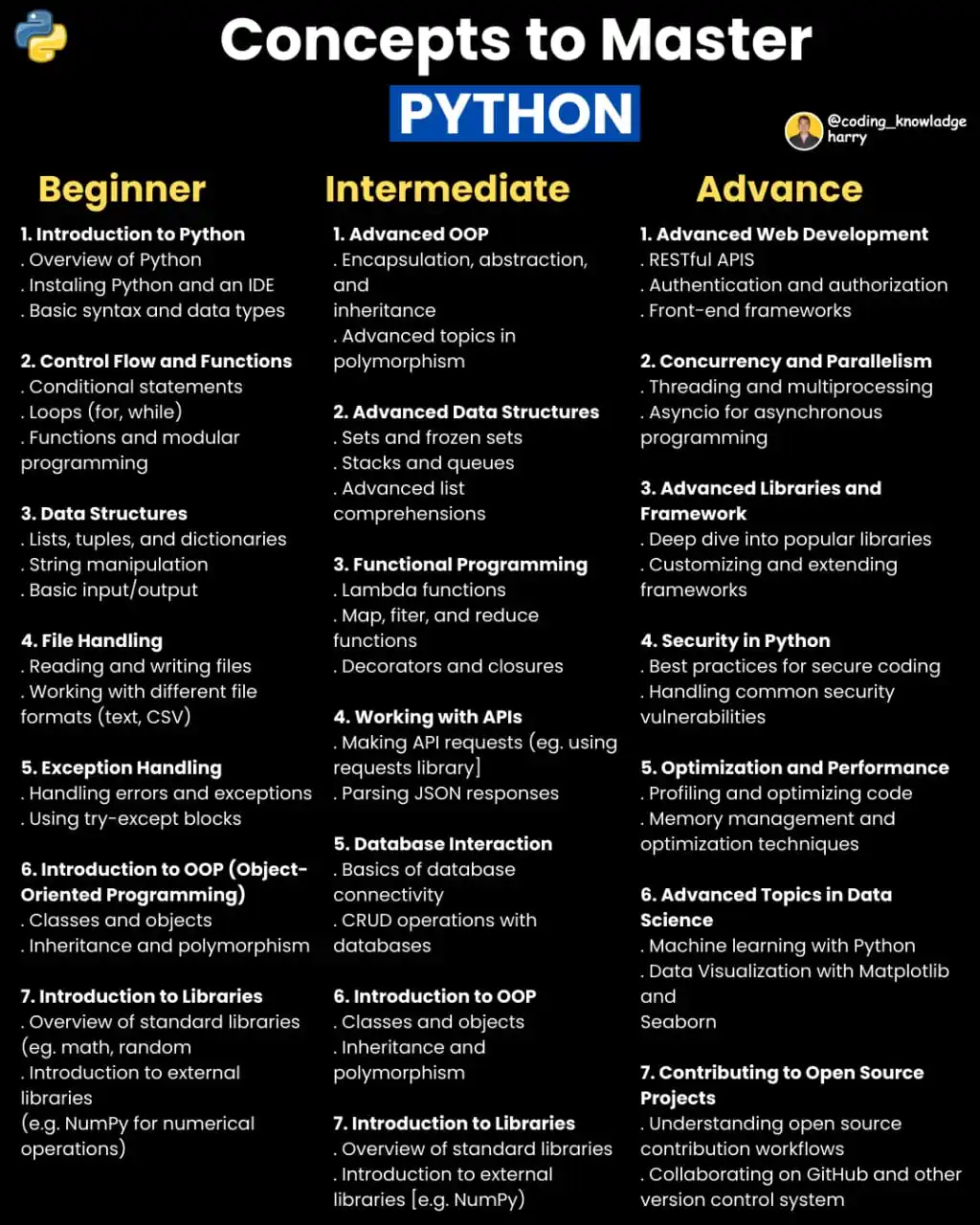
Tech_updates
20.8K subscribers
About Tech_updates
🚀Build a successful TECH Career An IITian helping you build a successful Tech Career! 👩🏻💻👨🏻💻 📌Get best guidance for Internship/ job / upskillng 💡 *SKILLS > Degree*. So this channel is for everyone who wants to build a Tech Career irrespective of background. Make sure you have turned the notifications on! 🚀 For enquiry/ promotions, DM*: [email protected] *Share the channel link with your friends!* 👨💻👨💻 https://whatsapp.com/channel/0029Vaa7CVhCRs1rxJzy1n3D
Similar Channels
Swipe to see more
Posts

*Top 40 SQL Interview Questions You Must Know* *Basics of SQL* 1️⃣ What is SQL? 2️⃣ What is a database? 3️⃣ What are the main types of SQL commands? 4️⃣ What is the difference between CHAR and VARCHAR2 data types? 5️⃣ What is a primary key? 6️⃣ What is a foreign key? 7️⃣ What is the purpose of the DEFAULT constraint? *Database Design & Normalization* 8️⃣ What is normalization in databases? 9️⃣ What is denormalization, and when is it used? *SQL Queries & Functions* 🔟 What is a query in SQL? 1️⃣1️⃣ What are the different operators available in SQL? 1️⃣2️⃣ What is a view in SQL? *Constraints & Joins* 1️⃣3️⃣ What is the purpose of the UNIQUE constraint? 1️⃣4️⃣ What are the different types of joins in SQL? 1️⃣5️⃣ What is the difference between INNER JOIN and OUTER JOIN? *Aggregations & Subqueries* 1️⃣6️⃣ What is the purpose of the GROUP BY clause? 1️⃣7️⃣ What are aggregate functions in SQL? 1️⃣8️⃣ What is a subquery? *Filtering & Indexing* 1️⃣9️⃣ What is the difference between the WHERE and HAVING clauses? 2️⃣0️⃣ What are indexes, and why are they used? *Data Manipulation & Optimization* 2️⃣1️⃣ What is the difference between DELETE and TRUNCATE commands? 2️⃣2️⃣ What is the purpose of the SQL ORDER BY clause? *SQL vs NoSQL* 2️⃣3️⃣ What are the differences between SQL and NoSQL databases? *Database Objects & Constraints* 2️⃣4️⃣ What is a table in SQL? 2️⃣5️⃣ What are the types of constraints in SQL? 2️⃣6️⃣ What is a cursor in SQL? 2️⃣7️⃣ What is a trigger in SQL? *SQL Statements* 2️⃣8️⃣ What is the purpose of the SQL SELECT statement? 2️⃣9️⃣ What are NULL values in SQL? 3️⃣0️⃣ What is a stored procedure? *DDL & DML Commands* 3️⃣1️⃣ What is the difference between DDL and DML commands? 3️⃣2️⃣ What is the purpose of the ALTER command in SQL? *Advanced SQL Concepts* 3️⃣3️⃣ What is a composite primary key? 3️⃣4️⃣ How is data integrity maintained in SQL databases? 3️⃣5️⃣ What are the advantages of using stored procedures? *Set Operations & Case Handling* 3️⃣6️⃣ What is a UNION operation, and how is it used? 3️⃣7️⃣ What is the difference between UNION and UNION ALL? 3️⃣8️⃣ How does the CASE statement work in SQL? *Functions & Special Operations* 3️⃣9️⃣ What are scalar functions in SQL? 4️⃣0️⃣ What is the purpose of the COALESCE function?

*SELF JOIN & CROSS JOIN IN SQL* *1. SELF JOIN* A SELF JOIN is a regular join where a table is joined with itself. *When to use:* When rows in the same table relate to each other. Example: Employees and their managers in the same employee table. *Example:* SELECT A.name AS employee, B.name AS manager FROM employees A JOIN employees B ON A.manager_id = B.id; Here, you're joining the employees table with itself to get each employee’s manager. *2. CROSS JOIN* A CROSS JOIN returns the cartesian product of two tables — every row of the first table combined with every row of the second. *When to use:* When you need all possible combinations. Useful in generating calendars, test data, etc. *Example:* SELECT * FROM colors CROSS JOIN sizes; If colors has 3 rows and sizes has 4 rows, the result will have 3 × 4 = 12 rows. *React with ❤️ if you're ready for the next quiz.* 📝

*Operators in Python* Operators are special symbols or keywords that perform operations on variables and values. *Types of Operators in Python:* *1. Arithmetic Operators* Used for basic math: + (add), - (subtract), * (multiply), / (divide), // (floor divide), % (modulus), ** (power) a = 10 b = 3 print(a + b) # 13 print(a ** b) # 1000 *2. Comparison Operators* Used to compare two values: ==, !=, >, <, >=, <= x = 5 print(x == 5) # True print(x != 3) # True *3. Logical Operators* Used to combine conditional statements: and, or, not age = 20 print(age > 18 and age < 25) # True *4. Assignment Operators* Used to assign values to variables: =, +=, -=, *=, /=, etc. score = 10 score += 5 # score is now 15 *Mini Project: Build a Simple Calculator* Let’s apply what we’ve learned! *Task: Build a calculator that asks the user to enter two numbers and an operator, then prints the result.* *Approach* 1. Take two numbers from the user. 2. Ask for an operator (+, -, *, /). 3. Perform the operation based on what the user entered. 4. Print the result, or shows "Invalid operator!" if the input is wrong. *Python Code*: num1 = float(input("Enter first number: ")) op = input("Enter operator (+, -, *, /): ") num2 = float(input("Enter second number: ")) if op == "+": print(num1 + num2) elif op == "-": print(num1 - num2) elif op == "*": print(num1 * num2) elif op == "/": print(num1 / num2) else: print("Invalid operator!") *React with ❤️ once you’re ready for the quiz*

Understanding Table Relationships in SQL *What are Table Relationships in SQL?* In real-world databases, data is stored across multiple related tables. Instead of repeating the same data, we link tables using keys. *Types of Relationships:* *1. One-to-One (1:1):* Each row in Table A is related to exactly one row in Table B. Example: A user and their profile. user_id in users links to profile_id in profiles. *2. One-to-Many (1:N):* A row in Table A can relate to multiple rows in Table B. Example: One customer can place many orders. customer_id in customers links to many rows in orders. *3. Many-to-Many (M:N):* Rows in both tables relate to multiple rows in the other. Example: Students and Courses. This needs a third table (bridge) like student_courses. *Keys You Should Know:* Primary Key: Uniquely identifies each row in a table. Foreign Key: A column that links to the primary key in another table. *React with ❤️ if you're ready for the next quiz.* 📝

Now, let's understand the above web development concepts in detail: *A - API (Application Programming Interface)* APIs are used to allow different software systems to communicate with each other. In web development, APIs enable your frontend (client-side) to interact with the backend (server-side) to fetch or send data. *B - Backend Development* Backend development focuses on the server-side of web applications. It deals with databases, server configuration, and application logic. Technologies like Node.js, Django, and Ruby on Rails are commonly used for backend development. *C - CSS (Cascading Style Sheets)* CSS is used to style the visual layout of a web page. It controls elements like colors, fonts, and spacing. CSS is critical for creating responsive and aesthetically pleasing websites. Modern CSS techniques include Flexbox and Grid. *D - DOM (Document Object Model)* The DOM represents the structure of an HTML document. It allows JavaScript to access and manipulate the content and structure of a web page dynamically. *E - Express.js (Web Application Framework)* Express.js is a lightweight and flexible Node.js web application framework. It simplifies the creation of server-side applications and APIs by providing useful tools for routing, middleware, and handling HTTP requests. *F - Frontend Development* Frontend development involves creating the user interface (UI) and the user experience (UX) of a web application. It focuses on the client-side aspects of the web and uses technologies like HTML, CSS, and JavaScript. *G - Git & GitHub* Git is a version control system that tracks changes in code, allowing developers to collaborate efficiently. GitHub is a platform that hosts Git repositories and facilitates collaboration through pull requests, issues, and branches. *H - HTTP/HTTPS* (HyperText Transfer Protocol) HTTP is the protocol used for transmitting data across the web. HTTPS is a secure version of HTTP, using encryption (SSL/TLS) to ensure data security. HTTPS is essential for protecting user data and maintaining privacy. *I - Index.html* index.html is the default page loaded by a web server when accessing a website. It serves as the entry point to a website and is usually the first page in the directory of a website. *J - JavaScript* JavaScript is the programming language that allows you to add interactivity to your web pages. It’s used for tasks like form validation, dynamic content updates, and creating web applications. JavaScript is essential for frontend development and works alongside HTML and CSS. *K - Keywords in SEO* Keywords are words or phrases that people use to search for content on search engines. In SEO (Search Engine Optimization), the proper use of relevant keywords in your content helps improve your site’s ranking on search engines like Google. *L - Layout (Flexbox & Grid)* CSS Flexbox and Grid are layout systems used to create flexible, responsive designs. Flexbox allows you to align items in one-dimensional layouts, while Grid enables two-dimensional layout systems, making web page designs easier to implement and manage. *M - Middleware* Middleware is software that sits between the client and the server, processing requests and responses. In web development, it can be used for tasks like authentication, logging, or handling errors. Express.js provides middleware that helps in these processes. *N - Node.js* Node.js is a JavaScript runtime built on Chrome’s V8 engine that enables JavaScript to be used for backend development. It’s asynchronous, event-driven, and perfect for building scalable network applications, such as web servers and APIs. *O - OAuth (Open Authorization)* OAuth is a protocol for authorization, allowing users to give third-party applications limited access to their resources without exposing credentials. For example, using Google login to authenticate on a website without sharing your password. *P - Progressive Web Apps (PWA)* PWAs combine the best features of both web and mobile apps. They are reliable, fast, and engaging, offering offline functionality, push notifications, and installation on mobile devices. PWAs are an important aspect of modern web development. *Q - Query Parameters* Query parameters are part of the URL and provide additional information for the server to process. For example, in a URL like https://example.com/search?query=webdev, the query=webdev is a query parameter that the server uses to perform a search. *R - RESTful APIs* REST (Representational State Transfer) is an architectural style for designing networked applications. RESTful APIs are based on HTTP methods and are used to create lightweight, stateless services that can be consumed by frontend applications to interact with backend systems. *S - Semantic HTML* Semantic HTML refers to using HTML tags that accurately describe the content they contain, such as <header>, <footer>, and <article>. This improves accessibility and SEO, making your content easier to understand for both browsers and search engines. *T - Tokens* (Authentication) Tokens are used in web development for secure authentication and authorization. A common implementation is JSON Web Tokens (JWT), which are used to securely transmit information between a client and a server, verifying the user's identity. *U - UI/UX Design* UI (User Interface) design focuses on how the product’s interface looks, while UX (User Experience) design deals with how users interact with the product. Both are crucial in ensuring a smooth, efficient, and enjoyable experience for users. *V - Version Control* Version control systems, like Git, help developers track changes, collaborate, and manage code over time. It allows teams to work together without overwriting each other’s work, making it easier to manage code revisions and releases. *W - Webpack* Webpack is a module bundler for JavaScript applications. It helps bundle JavaScript files and other assets like CSS, images, and HTML into optimized output files. Webpack is a critical tool for frontend development in large-scale applications. *X - XMLHTTPRequest (XHR)* XMLHTTPRequest is a JavaScript object that allows web browsers to make HTTP requests to retrieve data from a server without refreshing the page. It’s a fundamental part of AJAX (Asynchronous JavaScript and XML), which is used for dynamic web content. *Y - YAML in DevOps* (used in CI/CD pipelines) YAML (Yet Another Markup Language) is a human-readable data serialization format used in configuration files. In DevOps, YAML is used to define CI/CD pipeline configurations, enabling automated deployment and testing processes. *Z - Z-index in CSS* The z-index property in CSS controls the stacking order of elements on a page. Higher values will display elements on top of those with lower values, making it essential for layering elements like modals, dropdowns, or popups. These concepts are vital for anyone involved in web development, from frontend to backend to DevOps. Understanding these will allow you to develop complete and efficient web applications. *React ❤️ for more*

*Web Development Interview Questions* *HTML Interview Questions* 1. What is HTML? 2. What does DOCTYPE mean in HTML? 3. Explain the purpose of the <meta> tag. 4. What is the difference between HTML and XHTML? 5. What is semantic HTML? 6. Describe the difference between <div> and <span>. 7. Explain the use of the <canvas> element. 8. What are data attributes in HTML5? 9. What is the purpose of the alt attribute in the <img> tag? 10. How do you create a hyperlink in HTML? 11. What is the purpose of the <head> tag in HTML? 12. Explain the difference between <ol> and <ul> elements. 13. What is the significance of the lang attribute in HTML? 14. What is the purpose of the <form> element in HTML? 15. How does the target attribute work in HTML forms? *CSS Interview Questions* 16. What is CSS and what does it stand for? 17. Explain the difference between inline, block, and inline-block elements. 18. Describe the box model in CSS. 19. What is the purpose of the clear property in CSS? 20. Explain the difference between position: relative; and position: absolute;. 21. What is the CSS selector specificity and how is it calculated? 22. How can you center an element horizontally and vertically using CSS? 23. Explain the purpose of the float property in CSS. 24. Describe the difference between padding and margin. 25. How does the display: none; property differ from visibility: hidden;? 26. What is a CSS preprocessor, and why might you use one? 27. What is the "box-sizing" property in CSS? 28. How do you include external stylesheets in HTML? 29. What is the difference between em and rem units in CSS? 30. How does the z-index property work in CSS? *JavaScript Interview Questions* 31. What is JavaScript? 32. Explain the difference between let, const, and var in JavaScript. 33. Describe hoisting in JavaScript. 34. What is the purpose of the this keyword in JavaScript? 35. What are closures in JavaScript? 36. Explain the concept of prototypal inheritance in JavaScript. 37. How does event delegation work in JavaScript? 38. Describe the difference between == and === in JavaScript. 39. What is the purpose of the async keyword in JavaScript? 40. How do you handle errors in JavaScript? 41. Explain the concept of callback functions. 42. What is the difference between null and undefined in JavaScript? 43. Describe the role of the bind method in JavaScript. 44. What is the purpose of the map function in JavaScript? 45. Explain the concept of promises in JavaScript. 46. What is the event loop in JavaScript? 47. Describe the difference between null, undefined, and undeclared in JavaScript. 48. How do you create an object in JavaScript? 49. Explain the purpose of the localStorage and sessionStorage objects. 50. How does the typeof operator work in JavaScript? *HTML, CSS, and JavaScript Integration Questions:-* 51. How do you link a JavaScript file to an HTML file? 52. What is the purpose of the defer attribute in a script tag? 53. Explain how to include an external CSS file in an HTML document. 54. What is the importance of the viewport meta tag in responsive design? 55. Describe the purpose of the @media rule in CSS. 56. How do you include external JavaScript libraries in your project? 57. Explain the purpose of the <!DOCTYPE html> declaration in HTML5. 58. How can you optimize website performance using CSS and JavaScript? 59. What is the purpose of the lang attribute in the <script> tag? 60. How do you handle browser compatibility issues in CSS and JavaScript? *Responsive Design and CSS Frameworks Question:-* 61. What is responsive design? 62. Explain the difference between adaptive and responsive design. 63. Describe the purpose of media queries in CSS. 64. What is a CSS framework, and why might you use one? 65. How does a CSS grid system work in responsive design? 66. Explain the concept of a mobile-first approach in web development. 67. What is the importance of the viewport meta tag in responsive design? 68. How can you make a website accessible to users with disabilities? 69. What is the purpose of the rem unit in responsive design? 70. Explain the role of the max-width property in responsive design. *DOM Manipulation and Events Question:-* 71. What is the DOM? 72. How do you select elements with JavaScript in the DOM? 73. Explain the difference between innerHTML and textContent. 74. How does event delegation work in JavaScript? 75. What is the purpose of the addEventListener method? 76. How do you prevent the default behavior of an event in JavaScript? 77. Describe the difference between the focus and blur events. 78. Explain the purpose of the event.stopPropagation() method. 79. How can you dynamically create elements in the DOM with JavaScript? 80. What is the purpose of the data-* attributes in HTML5? *JavaScript ES6+ Features Question:-* 81. What are the arrow functions in JavaScript? 82. Describe the let and const keywords introduced in ES6. 83. What is destructuring assignment in JavaScript? 84. Explain the purpose of the template literals in ES6. 85. What are the let and const keywords in ES6? 86. How do you use the import and export statements in ES6? 87. What is the purpose of the spread operator (...) in JavaScript? 88. Describe the class syntax in ES6 and how it relates to object-oriented programming. 89. Explain the concept of promises and the async/await syntax in JavaScript. 90. What are the rest parameters in JavaScript? *Performance Optimization Question:* 91. How do you optimize the loading time of a web page? 92. Explain the concept of lazy loading in web development. 93. What is the purpose of bundling and minification in web development? 94. How can you reduce the number of HTTP requests on a web page? 95. Describe the importance of using a content delivery network (CDN). 96. What is tree shaking in the context of JavaScript and bundling? 97. Explain the difference between synchronous and asynchronous loading of scripts. 98. How can you optimize images for a web page? 99. Describe the significance of using the rel="preload" attribute. 100. What is the purpose of the "defer" attribute in a script tag, and how does it affect page loading? *React ❤️ for more*

*Python Cheatsheet* 🐍 This Cheatsheet covers the core Python concepts everyone should know. *1. Basics* print() – Outputs text to the screen. Comments – Use # for single-line and triple quotes """ for multi-line comments. print("Hello") # This will print Hello *2. Variables & Data Types* Variables store values of different types like numbers, strings, booleans, lists, etc. x = 10 # Integer name = "Alice" # String flag = True # Boolean *3. Conditionals* Used to make decisions in code using if, elif, and else. if x > 0: print("Positive") else: print("Not positive") *4. Loops* - For loop: Iterates over a sequence. - While loop: Repeats as long as a condition is true. for i in range(3): print(i) *5. Functions* A reusable block of code defined with def. def greet(name): return "Hello " + name *6. Lists & List Comprehension* - Lists: Store multiple items in one variable. - List comprehension: Short way to create lists. nums = [1, 2, 3] squares = [x**2 for x in nums] *7. Dictionaries* Key-value pairs, like a mini-database. user = {"name": "Bob", "age": 25} print(user["name"]) *8. String Methods* Strings are text, and Python provides handy methods to manipulate them. s = "hello" print(s.upper()) # "HELLO" print(s.replace("e", "a")) # "hallo" *9. File Handling* Read and write files using open(). with open("file.txt", "w") as f: f.write("Hi there!") *10. Error Handling* Prevents your program from crashing with try, except, and finally. try: x = 10 / 0 except: print("Error occurred") *11. Classes & Objects* Used in Object-Oriented Programming to create reusable code structures. class Dog: def __init__(self, name): self.name = name *12. Useful Built-in Functions* Handy tools built into Python. len(), type(), sum(), min(), max(), sorted() *React ❤️ for the detailed explanation of each Python concept*

*5 misconceptions about web development (and what's actually true):* ❌ You need to know everything — frontend, backend, DevOps, design ✅ Most web developers specialize in one area and collaborate with others ❌ You have to build everything from scratch ✅ Using frameworks, libraries, and templates is smart — not cheating ❌ Web development is just about writing code ✅ User experience (UX), design, and performance matter just as much ❌ Once a website is live, the job is done ✅ Websites need regular updates, testing, bug fixes, and performance optimization ❌ It’s all about making things look pretty ✅ Functionality, accessibility, and responsiveness are just as important as visuals *React ❤️ for more*













